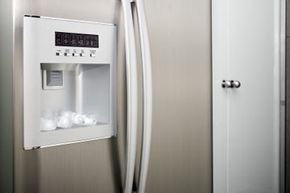Buying a New Freezer
Sticker shock aside, looking at new freezers might actually be fun. Depending on what your budget and needs are, today's freezers have all kinds of technologically advanced bells and whistles. Depending on which features you select, your new unit could cost anywhere from $500 to $4,000 or even more. Here a just a few of the features you might look for when considering your next freezer purchase:
- Digital external temperature regulator: This is a keypad where you tap in your freezer's desired temperature. It keeps you from having to reach into the back of a cold freezer to twist an icy knob that's frozen in place.
- Automatic ice-makers: Though they've been around for decades, icemakers in the door that you access externally will make your freezer last longer because that's one fewer time you don't have to reach inside and risk wear to the rubber seal.
- Cold water filter: You get fresh, chilled water dispensed from the freezer door.
- "Cooling zone" compartment: Available in some fridge/freezer combos is a hidden tube routing super-cold freezer air to a space in the fridge designed for storing items that perish quickly, such as milk.
- Automatic defrost: As we talked about earlier, this should prolong the life of your freezer so you won't have to go freezer shopping again anytime soon.
Learn even more about freezers and food preservation by visiting the links below.
Advertisement
Related HowStuffWorks Articles
Sources
- Bathroom Readers' Institute (eds.). "The Ice Age." In Curiously Compelling Bathroom Reader. (Ashland, OR: Portable Press, 2006), 387-390
- Bottom Freezer Refrigerators. Samsung. 2009. Accessed 13 Oct. 2009. http://www.samsung.com/us/consumer/appliances/refrigerators/bottom-freezer/index.idx?pagetype=subtype.
- Butterworth, Brent (ed.). "Refrigerator." In How Things Work. (Lincolnwood, Illinois: Publications International, 1990), 137
- Chapel, George L. "Gorrie's Fridge." Apalichola Area Historical Society. Accessed 1 Dec. 2009.http://www.phys.ufl.edu/~ihas/gorrie/fridge.htm
- Elert, Glenn. Refrigerators: The Physics Hypertextbook (1998-2005). Accessed 14 Oct. 2009. http://physics.info/refrigerators/index.shtml
- Environmental Protection Agency. "Nonessential Product Bans." May 14, 2009. Accessed 1 Dec. 2009.http://www.epa.gov/ozone/title6/noness/610summ.html
- Ferris, F.J. The Perkins Family. (2002). Accessed 13. Oct. 2009.http://www.hevac-heritage.org/victorian_engineers/perkins/perkins.htm
- Hakim, S.H. and I. Turiel. "Cost-Efficiency Analysis in Support of the Energy Conservation Standards for Refrigerator/Freezers." Accessed 2 Dec. 2009.http://eappc76.lbl.gov/drupal.files/ees/ashrae5.pdf
- The Knowledge Commons (eds.). "Thermos." In Instant Genius. (Ashland, OR: Portable Press, 2008), 209.
- Koff, Richard. "Air conditioner." In How Does It Work? (New York: Bonanza Books, 1961), 11
- Martin, Ron. "Ice Houses in Sussex." Sussex Industrial History 14 (1984-85). May 31, 2009. Accessed 15 Oct. 2009.http://www.icehouses.co.uk/sussex.htm
- National Center for Home Food Preservation. "Frequently Asked Freezing Questions."http://www.uga.edu/nchfp/questions/FAQ_freezing.html#3
- Shepard, Sue. Pickled, Potted and Canned: How the Art and Science of Food Preserving Changed the World. (New York: Simon and Schuster, 2000), 280-285http://books.google.com/books?id=pNxLRqSreGkC&lpg=PA6&dq=Potted%20and%20Canned%3A%20How%20the%20Art%20and%20Science%20of%20Food%20Preserving%20Changed%20the%20World&pg=PA6#v=onepage&q=&f=false
